Sólheimajökull Glacier: Fleeting wonder of the South
By Taylor van Biljon
In the middle of Iceland’s southern coast, is Sólheimajökull, the icy tongue of her fourth largest glacier.
Sólheimajökull Glacier: Fleeting wonder of the South
By Taylor van Biljon
In the middle of Iceland’s southern coast, is Sólheimajökull, the icy tongue of her fourth largest glacier.
Sólheimajökull Glacier continues to be one of the most easily accessed glaciers in the country. Approximately 5 kilometers north from Route 01, a summer visit to this sunny ice paradise is one of our favorite ways to cool off.
The Glacier:
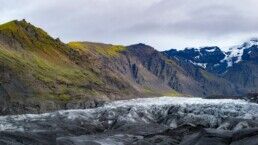
Sólheimajökull Glacier, or just Sólheimajökull (the “jökull” half stands for glacier), is one of the most visited glaciers in the southern region. Literally translated to “sun home glacier”, this icy tongue of the Mýrdalsjökull ice cap boasts some of the finest views of the southern coast, due to its fairly open surrounding terrain.
At nearly 15 kilometers long and 2 kilometers wide, this long strip of ice actually belongs to a larger parent glacier known as Mýrdalsjökull. Large glaciers often form complex established tongues or fingers as they melt, retreat, change, and shape themselves over time. Mýrdalsjökull is one such glacier, being the fourth largest in the country, and Sólheimajökull is one of its most well known outlet glaciers.
Notable for its varied crevasses, caves and color variations, Sólheimajökull is a popular option for activity and hiking. Still dusted in the 100 year old ashes of Katla, a walk up this ice giant is a trek back into a colorful and exciting history.
PLAN YOUR JOURNEY
Travelling to Iceland?
Check our overnight tours with a driver guide that includes a one night stay in a bubble.*Starting from ISK 74.900 per person
How do you get to Sólheimajökull?
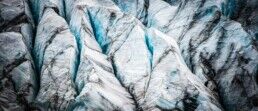
As part of the ice cap that houses the subglacial volcano Katla, Sólheimajökull can be found squarely in the center of the Katla Geopark, next to the park’s namesake. Sólheimajökull and Katla both are subjects of great scientific study due to their proximity and their relationship. The results of geothermal activity, climate change, and resulting jökulhlaups, or glacial floods, have been researched by many in the shadow of these natural giants. Though we cannot say for sure when Katla will next awaken, we can come learn about the way she and the glaciers shaped the land, and know that we are in great hands with the highly prepared southern guides.
Driving from Reykjavík: 2.5 hours
Driving from Vík: 45 minutes
If you have pre booked a tour, it may be possible that they are picking you up from your location. It can also be possible that you have access to a partial pickup, from a nearby location. This additional service needs to be arranged beforehand, so if this is how you’d like to arrive, be sure to confirm this with your tour provider, so that you know where and how to meet them.
If you are driving yourself to the glacier, know that in fair conditions you can expect a trip length of about 2.5 hours coming from Reykjavík. From Vík, you will be driving back towards Reykjavík for about 45 minutes.
From both areas, you will stay on Route 01 for the entirety of the drive, until you reach your turnoff onto Sólheimajökulsvegur. This is an unpaved road also labeled as 221, and it will be marked. After 10 minutes of careful driving, you’ll arrive at a car park, which is the furthest that your vehicle is permitted to go.
There is a cafe here, and many of the tour providers for the area will be meeting their groups in this area as well. This cafe is your last chance at a bathroom, so plan accordingly if you are headed out on the glacier.
If you are self-driving and have not booked a guided tour, you can still view the glacier. From the car park there is a short hike to the glacier’s lagoon, where you can view the accessible wall of Sólheimajökull. This is signage here to indicate the areas that are safe to occupy, and despite the absence of railing and gates- remember that the glacier is an unstable and changing environment that is dangerous to traverse without a professional guide.
To walk on the glacier it is imperative to be outfitted in the correct safety gear, and so hiking beyond the signage is strictly not advisable.
Noisy Neighbors:
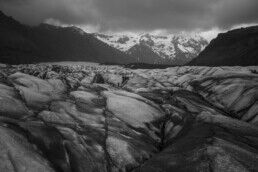
Sólheimajökull is wedged right in between two of Iceland’s most famous volcanoes. With the stratovolcano Eyjafjallajökull on the west, and overdue Katla on the right, these are some glaciers to watch! Eyjafjallajökull made international news from its 2010 eruption, and locals continue to tell the story of Katla’s great eruption in 1918. This eruption created much of the sand deserts surrounding this coastal region, and when you look at a satellite map, you can imagine the paths of the resulting jökulhlaup- one of the more dangerous side effects of Katla’s awakening.
If this weren’t enough, to the north we have Hekla, and the much quieter slumbering pair of Tindfjallajökull and Torfajökull. Tindfjallajökull is responsible for much of the lava formation of the land in the area, but has not erupted in modern history. After being asleep for 10,000 years, I suppose we can write them off as being the most amenable of all the neighbors.
Torfajökull is right behind them with a 1477 eruption- but Hekla on the other hand has rumbled forth as recently as 2000!
Volcanic activity is closely monitored by experts in Iceland, so you can rest assured that visiting these tepid neighbors is safe until otherwise noted. Information of an eruption or seismic event will be widely accessible, but it is always a good idea to check SafeTravel for any regional updates or warnings.
What can you do here?
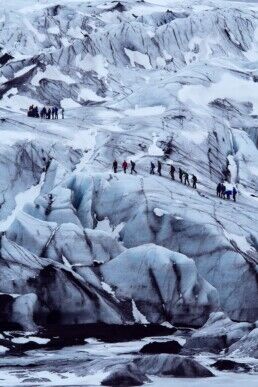
Sólheimajökull is a spectrum of activity. Unlike some areas, you can enjoy the ice here throughout the entire year. Beyond a self walk up to the lagoon, one can book a guided glacier walk or an ice climbing tour throughout the year.
These activities are open to all skill levels, and provide you with the correct gear to ensure safety. In the autumn and winter, it is possible to explore ice caves inside Sólheimajökull, and in the summer and autumn, to kayak in the lagoon before it. There are many guides that can lead these adventures safely, that can also inform you about the geological history of the area, and the changes that the glacier is going through, even now.
Sólheimajökull is receding and changing rapidly- and these guides are among the most familiar with this change. The lagoon in front of it is evidence of its retreat- a stark footprint of the change that our climate is forcing on the ice cap.
Remember that all of these experiences are subject to safety conditions on the glacier, and may or may not be available. The guides are expertly trained to gauge the safety of the glacier that day, and it is wise to heed those warnings. Few biomes change with the rapidity of a shrinking glacier, and though a cancelled trip may be disappointing, it is part of the respect that nature commands.
The impermanence of frozen treasures
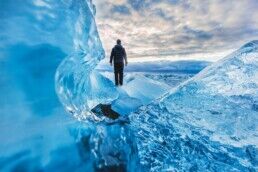
We hope that while you are visiting us, you do manage to venture out into glacier country. Whether you are staying with us in the Golden Circle and viewing the hulking Langjökull; or whether you are catching the sun with us in the south near Mýrdalsjökull, and the even greater Vatnajökull, with its many, many outlets- we recommend these giants with the full depth of our hearts.
They are an ancient treasure of our planet, and despite their many years of history- the change they are undergoing today is shockingly visible to the naked human eye.
Iceland is a country of wonders, but there are few things as poignant as the trickling melt sound of glaciers breaking apart, and joining the sea. The scale of it is immeasurable, and the effects of it will touch all of us in some way or another. If you’ve visited Sólheimajökull, or any glacier before, the reality of it may be very different on your second visit.
So go forth and bear witness to these frozen greats of our earth- for within the course of your lifetime, some of them may be no more.
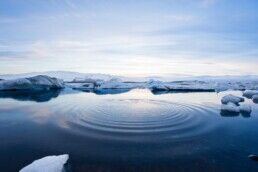
PLAN YOUR JOURNEY
Travelling to Iceland?
Check our overnight tours with a driver guide that includes a one night stay in a bubble.*Starting from ISK 74.900 per person